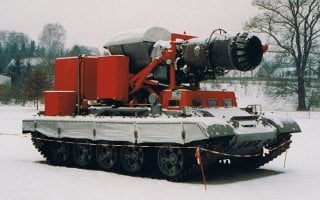Russia Looked at Jet Engines & Thought Put it On A Tank... to Fight Fires
Not much is known about this firefighting tank.
Here's What You Need to Know: Rather than fighting off insurgents, the tank was used to beat down fires.
Drawing on lessons learned during World War II, the T-34 family of tanks was improved by increasing their firepower and armor protection. The result was the T-54 and T-55 family of tanks, which hold the lofty distinction of being among the most-produced tanks in the world. Despite the tank family’s old age (they were originally designed over 75 years ago!), they still enjoy a moderate amount of usage, especially in conflicts that are somewhat lower in intensity and for armed groups that cannot afford modern main battle tanks.
In addition for use on austere and far-flung battlefields, the tank chassis became the base for a pretty surprising application. Instead of firing high-explosive or armor-piercing projectiles, the tank was modified to shoot water! Rather than fighting off insurgents, the tank was used to beat down fires.
Firefighting Duty
As a fire-fighting vehicle, the tank’s turret was removed. In its place, a jet engine was mated to the tank chassis along with a large tank for storing water. It has been reported that the engine in question was taken from MiG-21 airplane.
Obviously, a jet engine is not designed to ingest massive amounts of water. The idea for the fire-fighting jet-engine tank was that water stored in the T-55’s water tanks could be pumped in front of the jet engine. The strong amounts of wind and exhaust created by the jet engine could push small water droplets towards fires. Range was probably no more than a couple hundred meters, maximum.
The tank likely had a crew of two or three, as evidence by the protruding, multi-window crew compartment mated to the tank’s hull near the front. Like the T-54 and T-55 family of vehicles, the fire-fighting modification probably had room for a driver, commander, and a water-shooting gunner.
In addition to the good mobility offered by using a tank chassis, the water cannon itself appeared to be multidirectional. A frame supported the jet engine and very likely afforded the tank left-right and up-down movement. A large crane-like appendage on the tank’s left side also appears able to lift the jet into the air, which would have extended its firefighting range.
Postscript
A bit of online sleuthing reveals not much is known about the firefighting tank, though it was not the only tank used to fight fires. Another converted tank can be seen here, though this behemoth has not just one small MiG-21 engine, but dual jet engines of an unknown type that appear to be quite a bit larger and longer than the MiG-21 engine.
Further research indicates that the firefighting tank enjoyed only a short lifespan in the early 1990s and is likely no longer in use. One of them at least is now a museum piece, at the German Fire Museum at Fulda in Hesse, Germany. More’s the pity, a fire-fighting tank would be a wonder to see.
Caleb Larson is a multimedia journalist and Defense Writer with The National Interest. He lives in Berlin and covers the intersection of conflict, security, and technology, focusing on American foreign policy, European security, and German society.
This article first appeared in June 2020.
Image: Wikimedia Commons

